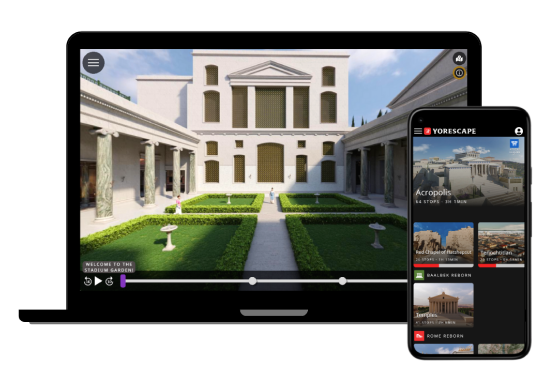
In this tour Flyover Zone takes you to the magnificent Karnak Temple Complex in Luxor, Egypt to explore the Red Chapel, the home of the ceremonial boat used to transport the sacred image of the god Amun in the fifteenth century before our era.

- Description
- Languages
- Credits
- Bibliography
In this tour Flyover Zone takes you to the magnificent Karnak Temple Complex in Luxor, Egypt to explore the Red Chapel, the home of the ceremonial boat used to transport the sacred image of the god Amun in the fifteenth century before our era. In 29 stops lasting approximately one hour you will learn about the Red Chapel's materials, decorations, meaning, function, location, and history, as well as the god Amun, his sanctuary at Karnak, and the religious festivals in his honor led by the pharaohs. The stars of the story of the Red Chapel are its builders, the female pharaoh Hatshepsut and her stepson and successor Thutmose III. Your guides are native Egyptian archaeologists.
Audio: English
Subtitles: Arabic, English, Spanish
Producer:
Bernard Frischer
Project Manager:
Hesham Hamed
Tour Guide/Narration:
Alberto Prieto
Script:
Hesham Hamed
Mostafa Mohamed
Ahmed Taher
Wesam Mohamed
Alberto Prieto
Bernard Frischer
Contributors:
Hesham Hamed
Mohamed Abdelaziz
Mostafa Mohamed
Waleed el-Sayed
Captions:
Hesham Hamed (Arabic)
Nancy Peniche May (Spanish)
Image Credits:
3D plan of Karnak complex by O H 237 via Wikimedia Commons, CC BY-SA 4.0
The Walters Art Museum 54.413; Henry Walters, 1911; CC0 1.0; www.thewalters.org
The Metropolitan Museum of Art, New York 29.3.2; Rogers Fund, 1929; CC0 1.0; www.metmuseum.org
Created By:
Flyover Zone Productions
- A. Bart, “Hatshepsut (Maatkare),“ https://mathstat.slu.edu/~bart/egyptianhtml/kings%20and%20Queens/Hatshepsut.html.
- L. Bell, “Luxor Temple and the Cult of the Royal Ka.” Journal of Near Eastern Studies 44.4 (1985): 251-294.
- T. Benderitter (trans. J. Hurst), https://www.osirisnet.net/monument/chaproug/e_chaproug.htm.
- F. Burgos and F. Larché, La chapelle rouge. Le sanctuaire de barque d’Hatshepsout. 2 vols. Paris: Éditions recherche sur les civilisations and Éditions Soleb, 2006-2008 and 2014.
- J.-F. Carlotti, “Mise au point sur les dimensions et la localisation de la chapelle d'Hatchepsout à Karnak.” Cahiers de Karnak X (1995): 141-166.
- M. Cornelissen, “Festivals and Feasts in Ancient Egypt: A Comparative Study of the Socio-political Implications of Festivals and Feasts in Egypt and Rome.” Bachelor’s Thesis, Leiden University 2019.
- B. A. Curran, “Obelisks in Ancient Egypt,” in H. Selin (ed.), Encyclopaedia of the History of Science, Technology, and Medicine in Non-Western Cultures (Dordrecht: Springer 2016), 3419-3435.
- J. Dunn, “The Peristyle Court of Tuthmosis III, The Naos of Philip Arrhidaeu and the Sanctuary of Hateshpsut Beyond the Sixth Pylon in the Temple of Amun At Karnak.” http://www.touregypt.net/featurestories/karnak7.htm.
- V. L. Emery, “Mud-brick Architecture,” in W. Wendrich, J. Dieleman, E. Frood, and J. Baines (eds.), The UCLA Encyclopedia of Egyptology (Los Angeles: UCLA Press 2011). https://escholarship.org/uc/item/4983w678.
- D. C. Forbes, “Red Chapel on the rise in the Open-Air Museum, Karnak.” KMT 9.3 (1998): 29.
- M. Fukaya, “Distribution of Life Force in the Festival of the Valley: A Comparative Study with the Opet Festival.” Orient 42 (2007): 95-124.
- A. Grassart-Blésès, “Les représentations des déesses dans le programme décoratif de la chapelle rouge d'Hatchepsout à Karnak: le rôle particulier d'Amonet.” Cahiers de Karnak XVI (2017): 253-268.
- N. Grimal and F. Larché, “Karnak, 1998-2004,” in Cahiers de Karnak XII.1 (Cairo and Paris: IFAO and Éditions Soleb, 2007), 7-56.
- F. Horn, “Terres cuites de la Basse Époque à Karnak. Sondages du secteur oriental du musée en plein air, zone 6,” in Cahiers de Karnak XII.1 (Cairo and Paris: IFAO and Éditions Soleb, 2007), 327-334.
- J.-F. Jet, “Sondage dans le secteur oriental du musée en plein air de Karnak: constructions d’époque saïto-perse,” in Cahiers de Karnak XII.1 (Cairo and Paris: IFAO and Éditions Soleb, 2007), 335-354.
- A. Kelany, M. Negem, A. Tohami, and T. Heldal, “Granite Quarry Survey in the Aswan Region, Egypt: Shedding New Light on Ancient Quarrying,” in N. Abu-Jaber, E. G. Bloxam, P. Degryse, and T. Heldal (eds.), QuarryScapes: Ancient Stone Quarry Landscapes in the Eastern Mediterranean (Geological Survey of Norway Special Publication 12; Trondheim: Geological Survey of Norway 2009), 87-98.
- P. Lacau and H. Chevrier, Une chapelle d'Hatshepsout à Karnak. Cairo: Institut français d’archéologie orientale, 1977.
- E. Lanöe, “Fouilles à l’est du VIe pylône: l’avant-cour sud et le passage axial.” Cahiers de Karnak XII.1 (Cairo and Paris: IFAO and Éditions Soleb, 2007), 373-390.
- F. Larché, “Nouvelles observations sur les monuments du Moyen et du Nouvel Empire dans la zone centrale du temple d’Amon.” Cahiers de Karnak XII.1 (Cairo and Paris: IFAO and Éditions Soleb, 2007), 407-592.
- F. Larché, “Monument Closeup: The Reconstruction of the So-Called 'Red Chapel' of Hatshepsut & Thutmose III in the Open Air Museum at Karnak.” KMT 10.4 (1999-2000): 56-65.
- F. Larché, “L'anastylose de la Chapelle Rouge.” Bulletin de la Société française d'égyptologie 145 (1999): 5-18.
- K. H. Leser, https://www.maat-ka-ra.de/english/bauwerke/red_chap/hat_redc.htm.
- Madain Project, https://madainproject.com/karnak_open_air_museum.
- I. N. A. Samiee Ahmed, “The Festive and Processional Pathways in Ancient Egypt: The Beautiful Feast of the Valley in Thebes - Case Study.” Thesis submitted to the Faculty of Tourism and Hotels, Suez Canal University 2019.
- I. Shaw and P. Nicholson, The British Museum Dictionary of Ancient Egypt. London: British Museum Press, 1995.
- M. Stadler, “Procession,” in W. Wendrich, J. Dieleman, E. Frood, and J. Baines (eds.), The UCLA Encyclopedia of Egyptology (Los Angeles: UCLA Press 2008). https://escholarship.org/uc/item/679146w5
- K. Stephan, Die Dekoration der "Chapelle Rouge" in Karnak: Struktur und Funktion. Norderstedt: Books on Demand GmbH, 2008.
- E. Sullivan, “Karnak: Development of the Temple of Amun-Ra,” in W. Wendrich, J. Dieleman, E. Frood, and J. Baines (eds.), The UCLA Encyclopedia of Egyptology (Los Angeles: UCLA Press 2011). https://escholarship.org/uc/item/1f28q08h.

Subscribe to our Newsletter
Receive updates and exclusive promotions from Flyover Zone






